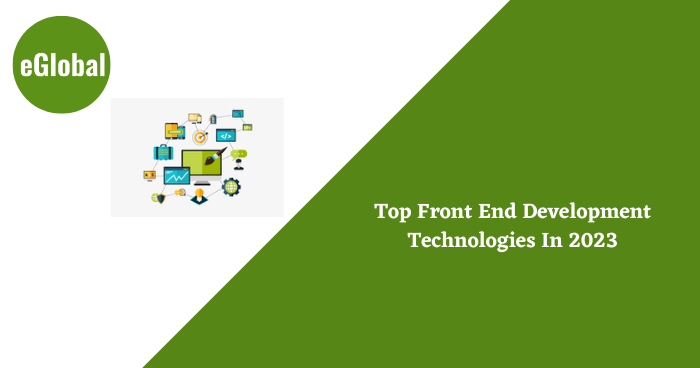

Since the pandemic and the WFH (work-from-home) culture have spread so widely over the past two years, the importance of digitalization and internet business has grown. All software solutions are successful due to frontend technology, which has developed increasingly common. Although the user will initially see and notice the front end, backend technologies are also quite significant. Users will initially view and interact with the front end. It is becoming more challenging to choose a frontend technology because it is being developed quickly. Let’s quickly review the salient features of frontend development before focusing on the list of frontend technologies.
The portion of software development visible to users is frontend development, also referred to as the User Interface that users may interact with. It transforms the complicated backend component into a user-friendly perspective through the usage of graphics. It aspires to the highest level of availability, performance, and speed.
The key benefits of frontend technology are an increase in output driven by users and productivity, a straightforward development technique for developers, task automation, and prototyping, easily understood and quickly developed. Are you trying to find msum d2l login?
To assist developers in creating mobile-first, responsive frontend programs, Bootstrap is a free CSS framework. A toolkit-like approach can be used to easily and quickly develop the frontend elements of responsive sites. The range of icons and motifs provided by its pre-built components encourage the development of original concepts. Both web development and mobile devices can use it because of its responsive design.
Ionic, a well-liked frontend platform, is ideal for building hybrid apps. Using frameworks, developers may construct effective and quick native and online apps using a single JavaScript codebase. The influence of plug-ins like Cordova and Capacitor on Ionic’s skill is equal. These components include a flashlight, camera, GPS, and other built-in devices. Ionic’s app development provides appealing cross-platform web, mobile, and desktop apps with open web protocols and a single code base. Additionally, Cordova or Capacitor can be used to package the creation of user interfaces, bringing them even closer to native tooling.
NPM stands for Node Package Manager. It acts as the default package manager for NodeJS. It is one of the world’s largest software registries. Developers share their code and reuse others with this powerful frontend technology for nodejs development services. This command-line utility can install, update, and uninstall the Node.js packages in the apps. It also functions as an online repository for several open-source Node.js packages.
Npm, the package manager for the Node.js platform, places the modules in the appropriate locations to enable nodes to detect and fix dependency problems quickly. It is pretty adaptable and can manage a variety of situations. It is ideal for creating, sharing, and discovering Node programs.
JavaScript is one of the most commonly used scripting languages on the Internet, along with HTML and CSS. Because of its adaptable abilities, it is best known for changing the web. It was interactive and included several functions, such as scrolling, clicking, pop-up windows, commercials, asynchronous calls, etc. It gives web pages live on the client side by acting as the base for numerous frontend frameworks. Throughout the world, developers use a variety of libraries. Calculations can be sped up, resulting in quicker page loading using a different JavaScript engine. It is a text-based programming language used to develop interactive web pages, dislodging static websites from both the server-side and the client-side primacy.
The AngularJS web app framework, built on TypeScript, is part of the MEAN technology stack. Using the MVVM design paradigm separates the business logic layer from the graphical user interface layer. Developers can create technologies like Ionic, Cordova, or progressive web app development using this framework’s flexibility. It has pre-built templates that help developers design user interface views more rapidly. With AngularJS, data binding is rapid and easy and requires little developer input. Two-way binding allows developers to manipulate the DOM, which helps them save a ton of time. The CPU is not under as much performance strain because it provides caching. The user experience is enhanced by quicker loading speeds and more straightforward navigation.
A full stack is built using a range of modules and packages by the JavaScript framework Meteor. It is recognized as the best frontend development tool because it is based on libraries and frameworks. Building an application prototype becomes more accessible, and developers may quickly create viable applications. Meteor and MongoDB have a close working relationship. Meteor is a good solution for new developers who are new to coding and have some familiarity with JS. This is one of the most straightforward frontend frameworks to learn. This open-source framework makes it easy to create full-stack JavaScript applications for the web, mobile, and desktop. You can quickly integrate technologies with Meteor as you use them.
This is all about top front end development technologies. Moreover, Personal preferences, mobile development, productivity, execution, and mobile readiness all play a role in selecting the technologies for frontend development. There are countless frontend technologies, and the list keeps growing. However, the ones mentioned earlier will effectively run the show in 2023!!
Hope this Article is beneficial for our readers! Hire developers in India from top rated Web development company India for your future projects.

May 9, 2025

May 8, 2025

May 6, 2025

© 2017 All rights reserved.